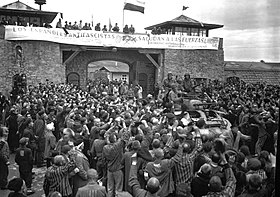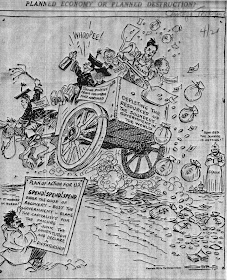The symbol of the NSDAP
Today in Social Sciences, today was the last day before the exam of unit 8: The interwar period. So we have dedicated this class principally to correct ours schemes about the Nazi Germany. We have used the PowerPoint presentation of Paqui to correct ours schemes.
We have started saying that the Nazi Germany had similar characteristics to the Fascist Italy. After, Paqui has remembered us that the Nazi party (the NSDAP) had to principal paramilitary groups: the SA or Assault Sections and the SS or Security Sections. Next to this, Paqui has asked for silence, She have said that when She is speaking we have to stay in silence.
The next section of the scheme was how the Nazi party reached power. Before start this section, Paqui has asked for silence again. This section has started with the Beer Hall Putsch, that was a planed Coup d' État in a beer hall in Munich. All the political authorities were celebrating a meeting. The plan failed because the army didn't joint the Nazis. Fourteen Nazis and their principal leaders were arrested. Hitler was sentenced to 5 years in jail, but he only stayed 8 months. In this time, we wrote the "Mein Kampf" (translated: My war), this book is consider the bible of Nazism. Actually, this book is forbidden is Germany. After this, the NSDAP results on the elections were not very good (you can find a summary of the elections on the slide 26 in the PowerPoint presentation of this unit). In January 1933, Hitler was promoted to prime minister. Hitler's first government included 3 Nazis out of 11 minister. Hitler call new elections for the 5th of march of 1933. The Nazis committed arson against the Reichstag (parliament) and they accused the communists. The government declared an emergency decree restricting liberties. Many of the communists were arrested and sent to the concentration camps.
On the 5th of March of 1933, the Nazis won the elections using intimidation and violence against the opposition with the 43% of the votes. They got the absolute majority. Hitler demanded absolute powers in the Reichstag. The Gestapo (secret police) was created and in July the NSDAP was the only legal party. The persecution against the Jews started immediately. On the 10th of March of 1933, the Nazis burnt books considered against Germany: Einstein (Jew), Marx (Jew), Hemingway, Proust, Heinrich and Thomas Mann. The members of the opposition parties started to work in concentration camps, commanded by the SS.
The Night of the long Knives was developed between June and Jule of 1934. Hitler eliminated the opposition inside his party, Ernst Röhm, leader of the SA, and other prominent Nazis were killed.
When President Hindenburg died in August of 1934, Hitler concentrated the post of chancellor and president and the Army swore fealty to him. He was proclaimed "Führer" (guide, leader) of the Germans and proclaimed the 3rd Reich (Empire).
The Nazis excluded the Jews for Germany nationality. In the Night of broken glass (9th November 1938), the Nazis attacked the synagogues and Jewish shops all around Germany. 90 Jews killed and more than 30,000 Jews were arrested to the concentration camps. There were a massive emigration of the Jews to other countries.
In March 1936, they started revising Versailles sanctions of WWI. In this moment, Paqui has said that we are disrespectful because we are speaking when she is also speaking.
Hitler claimed Sudetenland, a Czechoslovakian territory inhabited by 3 millions of German speakers. The main European powers accorded to cede Sudetenland to Germany with the promise that Hitler stop his territorial demands. The European powers saw Hitler as a powerful ally against Stalin. But Hitler didn't keep his promise. The Nazis started to occupied Czechoslovakia and Hitler signed secretly an agreement with the URSS to part Poland in two. Hitler wanted to neutralize the URSS in the invasion of Poland and Stalin wanted to gain time to be ready for the next war against the Nazis.
The 1st of September of 1939, the Nazis started the invasion of Poland using Thunder War: combined attack of artillery and air attacks (Poland was occupied in four weeks). The 3rd of September of 1939, the United Kingdom and France declared war to Germany. And the 17th of September of 1939, the Soviet Union occupied the Eastern part of Poland, Finland, Estonia, Latvia and Lithuania.
Next to this part of the class, Paqui has shown as another PowerPoint presentation with a slides of the expansion of the terriotories that Germany occupied during this period.
In this moment, the bell has rung and Paqui has said to us that study to pass the exam.
Well, this is all we have done is this class. Good luck for tomorrow. Juan Carlos









.JPG)
.svg.png)


.jpg)

























